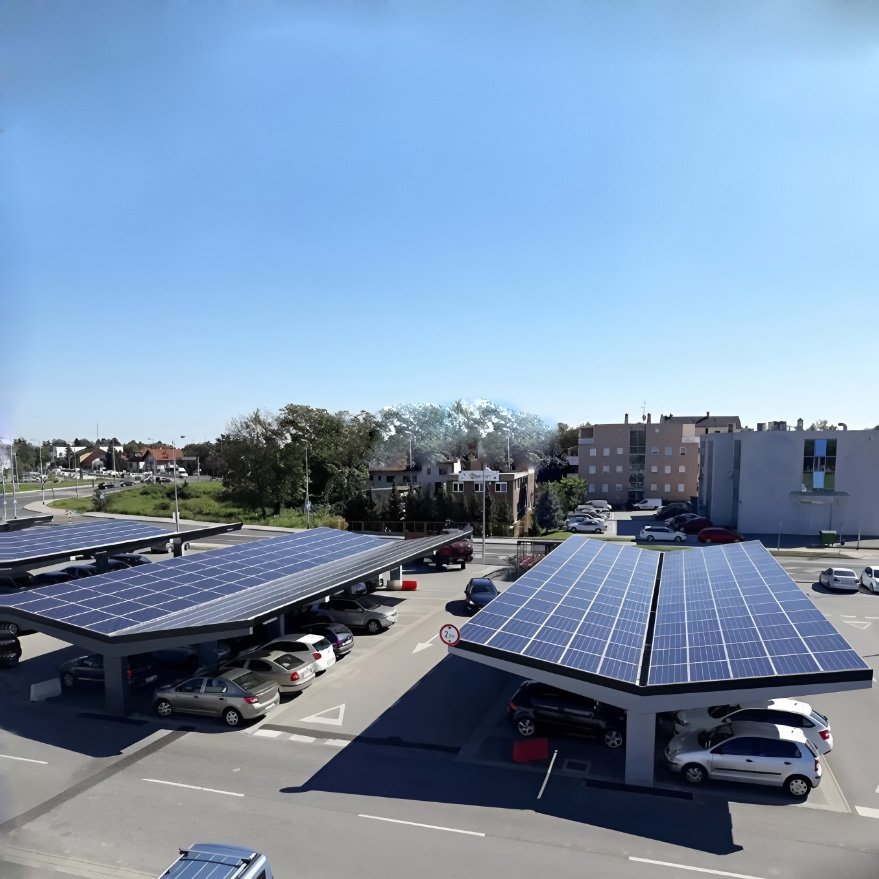Solar Canopies: The Integration of Green Architecture and Energy Innovation
Solar canopies, as a combination of photovoltaic technology and architectural design, not only fulfil the traditional functions of canopies—providing natural light and shade—but also generate clean energy through photovoltaic panels, making them an important choice for modern green buildings. The following analysis explores four key aspects: core definition, core advantages, design features, and implementation recommendations.

I. Core Definition of Solar Canopies
Solar canopies refer to architectural structures installed on villa roofs or balconies that integrate solar photovoltaic power generation systems. They utilise transparent or semi-transparent photovoltaic modules as covering materials, providing natural lighting, shading, and rain protection while converting solar energy into electricity, thereby achieving the dual objectives of ‘architectural aesthetics and energy self-sufficiency.’ Compared to traditional sunshades, its core difference lies in its energy-producing attributes, making it an ‘integrated design of a micro-distributed photovoltaic power plant and architectural components.’
II. Core Advantages of Solar Sunshades
1. Dual Benefits of Environmental Protection and Energy Conservation
Reduced carbon emissions: By replacing traditional thermal power generation with solar power, reliance on fossil fuels is reduced, directly lowering greenhouse gas emissions.
Enhanced energy utilisation efficiency: Photovoltaic modules convert idle sunlight into electricity, enabling tiered energy utilisation, particularly suitable for scenarios with stable energy demand.
Reduced building energy consumption: The covering materials can regulate indoor temperature, reducing air conditioning use and indirectly lowering building operational energy consumption.
2. Economic Value and Space Appreciation
Long-Term Electricity Cost Savings: Photovoltaic power generation can meet self-consumption needs, with excess electricity sold back to the grid, creating an ‘on-site consumption + surplus electricity revenue’ economic model.
Expanded Usable Space: The area beneath the solar canopy can be used for leisure, gardening, or storage, increasing the building’s actual usable area.
Enhanced Property Value: Green energy facilities enhance the building’s market competitiveness, becoming a highlight for property appreciation.
III. Design and Technical Features of Solar Canopies
1. Integration of Structure and Aesthetics
Customised Design: Support structures and photovoltaic modules can be flexibly adjusted according to roof slope and architectural style, supporting fixed or movable installation methods to ensure harmony with the building’s exterior.
Lightweight Materials: Aluminium alloy or high-strength steel is used to ensure load-bearing safety while reducing structural load on the building.
2. Technical Stability and Low Maintenance Costs
Long-Lifespan Components: High-quality photovoltaic panels have a lifespan of over 25 years, and the support system features corrosion-resistant design to withstand outdoor environments.
Smart Operations and Maintenance: Some systems are equipped with remote monitoring functionality to monitor power generation and equipment status in real-time, reducing the frequency of manual maintenance.
IV. Implementation Challenges and Recommendations for Advancement
1. Existing Challenges
High Initial Investment: Photovoltaic components, support structures, and installation costs constitute the primary upfront expenses, which may influence user decision-making.
Regional Adaptability Differences: Regions with poor sunlight conditions have lower power generation efficiency, necessitating the integration of energy storage equipment to enhance stability.
2. Implementation Pathways
Policy Support: Reduce user costs through policies such as subsidies and tax incentives, e.g., some regions offer feed-in tariffs for distributed photovoltaic projects.
Technological Innovation: Develop high-efficiency heterojunction photovoltaic modules and flexible mounting systems to enhance power generation efficiency and installation flexibility.
Demonstration project promotion: Build benchmark cases such as ‘photovoltaic sunshade + villa community’ and ‘photovoltaic sunshade + agricultural greenhouse’ to enhance market awareness.
Conclusion
Solar sunshades are not only a physical integration of energy production and building functionality but also a vivid practice of green living concepts. With declining technology costs and increased policy support, they will become an important choice for future building energy retrofits, injecting micro-level momentum into the achievement of the ‘dual carbon’ goals.
